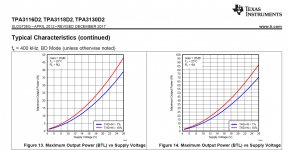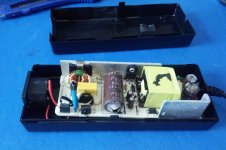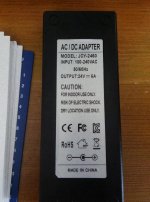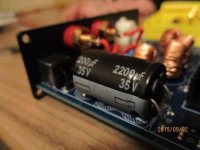I'm using this amplifier: Buy Products Online from China Wholesalers at Aliexpress.com
To drive: 2x JBL602 4ohm car speakers.
It's for arcade machine sound effects, but I'll also use them for music.
My question is what voltage and amperage do I select for the power supply? 18V or 24V and then what current rating?
I get stuck with the calculations right away, with a 18V supply what is the max RMS power per channel that I could get into 4ohms?
Where I get stuck is: does 18V supply give me a max signal of -9V to +9V ??? (therefore 6.4V RMS, 1.6A , 10W per channel ?)
To drive: 2x JBL602 4ohm car speakers.
It's for arcade machine sound effects, but I'll also use them for music.
My question is what voltage and amperage do I select for the power supply? 18V or 24V and then what current rating?
I get stuck with the calculations right away, with a 18V supply what is the max RMS power per channel that I could get into 4ohms?
Where I get stuck is: does 18V supply give me a max signal of -9V to +9V ??? (therefore 6.4V RMS, 1.6A , 10W per channel ?)
Attachments
Last edited:
There is a chinesium 25v power cap onboard so I would not use more then 20V. Clean output (1% thd) at 4 ohm reads 42W. 2 channels makes 84W max = 4.2A but you can go about 1/3 lower as most power supplies can deliver a peak higher then they are rated for continuous.
A standard laptop power supply, about 19v 3A will work fine.
A standard laptop power supply, about 19v 3A will work fine.
Last edited:
For 8 ohm loads you can safely go to 24 volts with most of these tpa3116 amps in which case you want at least 4 amps continuous power. There is a small risk of the 25 volt cap being off-spec so you may want to consider swapping it for a 35 volt one of the same value.
For 4 ohms, I would follow @Think's recommendation to stay at 20 volts or less to prevent overheating the chip.
For 4 ohms, I would follow @Think's recommendation to stay at 20 volts or less to prevent overheating the chip.
I get stuck with the calculations right away, with a 18V supply what is the max RMS power per channel that I could get into 4ohms?
Where I get stuck is: does 18V supply give me a max signal of -9V to +9V ??? (therefore 6.4V RMS, 1.6A , 10W per channel ?)
You are close. The outputs are actually swinging from +0 to +18 volts. But since they are configured BTL, as one amp is swinging from +0 to +18 on one side of the speaker, the other side of the speaker is swinging from +18 to +0. This doubles the RMS voltage to 12.8 volts. Now you have 3.2 amps and 40 watts per channel.
Mike
OK thanks everyone. I hadn't grasped that the power graph was showing bridged into a single speaker. I've got a 18V 3A brick on the way.
Up to now I've been using 12V mini amps eg Lepai 2020A which do the job well enough but looks cheap, so the main reason for the upgrade isn't for more power.
I wanted to understand the PS requirements though. I never trusted the current ratings on the wall-warts and some of these 12V mini amps have refused to turn on if they are tried with a weedy PS. And I've had clipping problems at moderate sound levels.
Last week I got some 100W resistors so I could test the bricks/wall-warts that I've got here. Most were Ok, dropping eg 0.5V at max current. But 3 of them (rated 2A) when tried across the 12ohm (ie 1A test) dropped to 4.5V.
I put one of the duffers in my arcade machine to test with the Lp202a. It turned on and sounded fine at my normal volume, but when I turned it up the amp started cutting out. Swapping in a 12V 5A supply handled that volume setting and a lot more.
Up to now I've been using 12V mini amps eg Lepai 2020A which do the job well enough but looks cheap, so the main reason for the upgrade isn't for more power.
I wanted to understand the PS requirements though. I never trusted the current ratings on the wall-warts and some of these 12V mini amps have refused to turn on if they are tried with a weedy PS. And I've had clipping problems at moderate sound levels.
Last week I got some 100W resistors so I could test the bricks/wall-warts that I've got here. Most were Ok, dropping eg 0.5V at max current. But 3 of them (rated 2A) when tried across the 12ohm (ie 1A test) dropped to 4.5V.
I put one of the duffers in my arcade machine to test with the Lp202a. It turned on and sounded fine at my normal volume, but when I turned it up the amp started cutting out. Swapping in a 12V 5A supply handled that volume setting and a lot more.
update:
I used the amp for a while with 18V 3A supply and then shipped it to a customer.
Then I started using the same model amp with a 24V 6A supply (all I had that was >12V ) after two weeks of intermittent use it blew up in the middle of the night. Anyone see a problem with this supply? is 270V OK for that cap (other similar PS I have use 400V).
Amplifier survived and I'm using a 19V 3.4A PS now. I have a gut feeling the laptop supplies might be better quality ????
I used the amp for a while with 18V 3A supply and then shipped it to a customer.
Then I started using the same model amp with a 24V 6A supply (all I had that was >12V ) after two weeks of intermittent use it blew up in the middle of the night. Anyone see a problem with this supply? is 270V OK for that cap (other similar PS I have use 400V).
Amplifier survived and I'm using a 19V 3.4A PS now. I have a gut feeling the laptop supplies might be better quality ????
Attachments
That is amazingly bad. Given your UK flag I would assume you are on 220-240VAC so expect 339V rectified peak indicating your suggested 400VDC rating for that capacitor. Does the supply claim to be rated for 220VAC use or is it marked for 110VAC only.
It is marked 110-240VAC.
Thanks for the comment, and no offense meant MorbidFractal, but I'd appreciate further confirmation of what you said. For all I know there might be a design for which 250V is adequate (not 270V as stated earlier)
Thanks for the comment, and no offense meant MorbidFractal, but I'd appreciate further confirmation of what you said. For all I know there might be a design for which 250V is adequate (not 270V as stated earlier)
Attachments
Last edited:
It is marked 110-240VAC.
Thanks for the comment, and no offense meant MorbidFractal, but I'd appreciate further confirmation of what you said. For all I know there might be a design for which 250V is adequate (not 270V as stated earlier)
Do the math ... 240vac is an RMS voltage so translate it to peak voltage...
peak == RMS X 1.414 == 240 X 1.414 == 339 volts.
So when you rectify the line voltage that cap ends up with ~330 volts on it.
To be honest, I'm surprised that 250 volt bulk cap lasted as long as it did. 400 volts would be far more reasonable for European use.
(This, btw, is why I no longer buy from AliExpress or EBay... too many counterfeit and re-labelled products.)
FWIW... My power here is 110vac, so the power supply is less of an issue. But a lot of these mini-amps are coming from China with marginal bulk caps in them. The TPA3116 loves to be on 20 to 24 volts, but most of these little amps ship with 25 volt caps in them. I routinely upgade them to 2200 uf 35 volts before letting them out into the wild with 24volt 4 amp supplies attached. Curiously, the provision for this is most often included right on the board.
Attachments
Last edited:
Yeah, I follow those calcs, but I can't tell looking at the board if those calcs apply. eg I've just remembered half wave rectification, presumably 250V would be (just) adequate for that.
PS. I'll stick to 19V supply for now given the previous warning about the 25V caps inside the amp (which I had forgotten!)
PS. I'll stick to 19V supply for now given the previous warning about the 25V caps inside the amp (which I had forgotten!)
Last edited:
Yeah, I follow those calcs, but I can't tell looking at the board if those calcs apply. eg I've just remembered half wave rectification, presumably 250V would be (just) adequate for that.
Half wave or full wave the resulting voltage is the same.
PS. I'll stick to 19V supply for now given the previous warning about the 25V caps inside the amp (which I had forgotten!)
I just updated my previous to show how I upgrade the caps. As I mentioned, the provision to do this is most often right on the board. It just requires a bit of soldering skill.
update 2:
I just got refunded by the seller. But it's out of time for me to leave feedback comments. I want to do my bit to help get rid of these crap products, because I want a reliable supply (of power supplies).
For the moment my quality control will consist of: stress test it to max current for a few minutes when it arrives. Then use it myself for a week or two before I incorporate it into a customer machine. This is doable because I make one arcade machine at a time.
I just got refunded by the seller. But it's out of time for me to leave feedback comments. I want to do my bit to help get rid of these crap products, because I want a reliable supply (of power supplies).
For the moment my quality control will consist of: stress test it to max current for a few minutes when it arrives. Then use it myself for a week or two before I incorporate it into a customer machine. This is doable because I make one arcade machine at a time.
update 2:
For the moment my quality control will consist of: stress test it to max current for a few minutes when it arrives. Then use it myself for a week or two before I incorporate it into a customer machine. This is doable because I make one arcade machine at a time.
You stand a much better chance of getting good product from Amazon, and their prices are only pennies higher.
Good luck with your arcade machines...
Ah yes. doh!Half wave or full wave the resulting voltage is the same.
I just updated my previous to show how I upgrade the caps. As I mentioned, the provision to do this is most often right on the board. It just requires a bit of soldering skill.
Thanks. I will do this when I use the amp for my music. For the customer arcade machines I'll stick with 19V supply, it's plenty loud enough when your head is 300mm from the speakers !
It is marked 110-240VAC.
Thanks for the comment, and no offense meant MorbidFractal, but I'd appreciate further confirmation of what you said. For all I know there might be a design for which 250V is adequate (not 270V as stated earlier)
Sorry. I went for an afternoon kip. As far as I know there is no reasonable cost effective way to bulk rectify AC mains lower than its peak at any reasonable power level, full or half.
It may be possible to contact e-bay directly and warn them about this product. Poke around...
https://www.ebay.co.uk/help/call_me?initFrom=HOME
and pick on anything that is going to get them to give you a response number then wing it when you get through to an operator.
Of course the seller is likely to just relist under another name.
I advised the seller what you guys said about the capacitor, hopefully he'll do the right thing.
What range of uF would be suitable to replace the blown capacitor? I've got a 400V 100uF here but looking to see what I can buy (on ebay!)
What range of uF would be suitable to replace the blown capacitor? I've got a 400V 100uF here but looking to see what I can buy (on ebay!)
I advised the seller what you guys said about the capacitor, hopefully he'll do the right thing.
What range of uF would be suitable to replace the blown capacitor? I've got a 400V 100uF here but looking to see what I can buy (on ebay!)
I would suggest 400v same value 270uf. More would increase the loading on the rectifier when powering up, less might not provide adequate filtering.
- Home
- Amplifiers
- Class D
- Help me size power supply for TDA3116 amp





